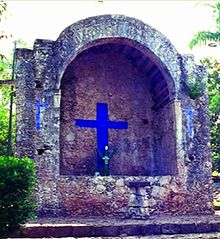Talking cross
The Speaking Cross ( Spanish Cruz parlante , Mayathan Chan Santa Cruz ) was an oracle of the insurgent Maya during the caste war from 1847 to 1901 , which formed the core of the political center of the Maya, Chan Santa Cruz .
In 1850, during the Caste War, the Mayan leader Jose María Barrera found a small cross cut into a tree in an uninhabited wooded area next to a small cenote called Lom Ha ' ("split spring"). God is said to have spoken to him through this cross and encouraged him to continue the fight, and so a shrine was created here. Manuel Nahuat, a companion of Barrera, passed God's words on to the Mayan fighters as a ventriloquist . In the following years, white prisoners of war had to build the Mayan Temple of the Speaking Cross ( Báalam Nah , "House of the Jaguar"), in which there was a prayer niche with three crosses. The place Chan Santa Cruz was built around the temple.
The rite of the speaking cross represents a syncretistic amalgamation of ancient Mayan religion with Christian symbolism. The cross contained three elements of the ancient Mayan religion: It grew on the roots of a kapok tree , the sacred tree of life ( Ya'axche ' , Spanish Ceiba ), which grew out of a cave ( Áaktun , sacred place of the Mayas), which was at a cenote (Ts'ono'ot) (place of the rain gods Cháak ).
The Keeper of the Cross ( Nohoch Tàatich , "Great Lord") received his orders from God by consulting the oracle of the Speaking Cross. He was the supreme spiritual and military authority over the Kruso'ob ("Kreuzler", also Cruzoob ). It is said that God repeatedly ordered the Tàatich to fight hard against the whites, so that he regularly encouraged the Maya fighters to continue the fight and prevented them from concluding a truce with the whites. The two best-known Tàatich were Venancio Puc (1858–1864) and Crescencio Poot (1875–1885), feared by the whites and admired by the Maya.
There was another speaking cross in Tulum (Tulu'um) , which was guarded by the Mayan priestess María Uicab , the so-called "Queen of Tulum". In addition, there were speaking crosses in the Mayan sites of Muyil (near the ancient Mayan temples of Chunyaxche), Xpalma , Chumpón and X-Cacal Guardia (also Xcacal or Tixcacal Guardia ).
After the conquest of the city of Chan Santa Cruz in 1901, the Temple of the Speaking Cross was razed to the ground by General Ignacio Bravo . However, the Mayan priests retreated into the woods and the cult lived on. After the last Mayan fighters of the cross (cruzoob) recognized Mexican rule in a peace treaty in 1935 , the cult was tolerated by the Mexican government. Today it is still maintained in the four places X-Cacal Guardia, Chancah Veracruz, Chumpón and Tulúm. No white person or any other stranger is allowed to the cross.
literature
- Don E. Dumond: The Talking Crosses of Yucatan: A New Look at Their History. In: Ethnohistory. Volume 32, No. 4, 1985, pp. 291-308, doi: 10.2307 / 481891 .
Web links
- Logan Hawkes: In Search of the Talking Cross of Chan Santa Cruz
- Jeanine Kitchel: The Caste War, the Church of the Speaking Cross, and the Cruzob Maya ( Memento from December 19, 2006 in the Internet Archive ) (English)
- Richard D. Perry (2001): A Visit to Chan Santa Cruz ( Memento of July 21, 2011 in the Internet Archive ) (English)
- María Teresa Gamboa Gamboa, Archivo General del Estado de Quintana Roo: María Uicab - La Santa Patrona de Tulum (Spanish)
Coordinates: 19 ° 34'52.2 " N , 88 ° 2'55.9" W.
